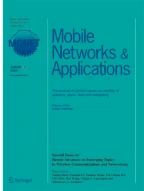Abstract
An efficient Media Access Control (MAC) protocol for wireless Internet access is developed in this study. The proposed access protocol exploits the fact that very often the Internet access messages, such as HTTP download requests, are based on short packets. In addition, whenever the user is able to access to multiple overlapping base stations (e.g., in WiMAX access networks, or in 3GPP cellular networks), the proposed protocol enables the user to select the least loaded base station. Consequently, the user gets a better quality of service, while load balancing is achieved by preferring links that are less loaded over congested links. The key idea is to adjust the access probability to the load on the local link, and to use a different access protocol for short messages. Delay insensitive and long messages are transmitted using a Request To Send (RTS) and Clear To Send (CTS) mechanism, in a similar way to IEEE 802.11, over hops that are able to support this protocol type, while short and delay-sensitive messages are transmitted using another method, that offers a reduced call delivery delay, as well as better channel utilization. Whenever the message length drops below a certain threshold (evaluated in this study), the overhead of transmitting an RTS and CTS messages becomes too large. The analysis in this study shows that this threshold is load-dependent. Whenever the message length drops below this load-dependent threshold, this study proposes to use a protocol which is more efficient for short messages transmissions, such as HTTP download requests, Short Message Service (SMS) messages, and signaling messages. The proposed MAC protocol is especially suitable for 3G and beyond cellular networks. Whenever there are number of channels that can be possibly used to deliver a message, it enables to select the least loaded channel among several channels.
Similar content being viewed by others
References
Bianchi G, Tinnirello I (2003) Kalman filter estimation of the number of competing terminals in an IEEE 802.11 network. In: IEEE INFOCOM
Bianchi G (2000) Performance analysis of the IEEE 802.11. Distributed coordination function. JSAC 18
Bertsekas D, Gallager R (1992) Data networks, 2nd ed. Prentice Hall, Englewood Cliffs
Bikel PJ, Doksum KA (1977) Mathematical statistics- basic ideas and selected topics. Holden-Day, San Francisco
Bruno R, Conti M, Gregori E (2002) Optimization of efficiency and energy consumption in p-Persistent CSMA-based wireless LANs. IEEE Trans Mob Comput 1:10–31
Fayolle G, Gelenbe E, Labetoulle J (1977) Stability and optimal control of the packet switching broadcast channel. J Assoc Comput Mach 24(3):375–386
Chhaya HS, Gupta S (1997) Performance modeling of asynchronous data transfer methods of IEEE 802.11 MAC protocol. ACM Journal on Wireless Networks 3:217–234
Hajek B, Loon T (1982) Decentralized dynamic control of a multiaccess broadcast channel. IEEE Trans Automat Contr 27(3):559–569
Haas Z, Deng J (2002) Dual busy tone multiple access (DBTMA)—a multiple access control for Ad Hoc networks. IEEE Trans Commun 50
IEEE 802.11 Working Group (1999) Part 11: wireless LAN medium access control (MAC) and physical layer (PHY) specifications. ANSI/IEEE Std 802.11
IRCACHE, The NLANR Web Caching project, ftp.ircache.net. www.ircache.net/FAQ/
Kleinrock L, Lam S (1975) Packet switching in a multiaccess broadcast channel: dynamic control procedures. IEEE Trans Commun 23:891–p04
Kleinrock L (1976) Queueing systems, vols 1–2. Wiley, New York
Lindemann C, Thummler A (2003) Performance analysis of the general packet radio service. Comput Networks J 41:1–17
Naor Z, Levy H (2001) A centralized dynamic access probability protocol for next generation wireless networks. In: IEEE INFOCOM 767–775
Naor Z (2004) An efficient short messages transmission in cellular networks. In: IEEE INFOCOM
Rivest RL (1985) Network control by Bayesian broadcast. MIT report no 285
Sheu S-T, Chen T, Chen J, Ye F (2002) The impact of RTS threshold on IEEE 802.11 MAC Protocol. In: Proc 9th international conference on parallel and distributed systems (ICPADS02)
Tanenbaum AS (1996) Computer networks, 3rd ed. Prentice-Hall, Englewood Cliffs
Author information
Authors and Affiliations
Corresponding author
Rights and permissions
About this article
Cite this article
Naor, Z. LAMA/CA: A Load-Adaptive MAC Protocol for Short Packets. Mobile Netw Appl 15, 639–651 (2010). https://doi.org/10.1007/s11036-009-0197-y
Published:
Issue Date:
DOI: https://doi.org/10.1007/s11036-009-0197-y
